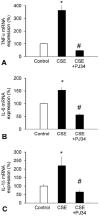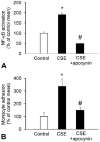Oxidative stress and accelerated vascular aging: implications for cigarette smoking
- PMID: 19273262
- PMCID: PMC2756477
- DOI: 10.2741/3440
Oxidative stress and accelerated vascular aging: implications for cigarette smoking
Abstract
Cigarette smoking is the major cause of preventable morbidity and mortality in the United States and constitutes a major risk factor for atherosclerotic vascular disease, including coronary artery disease and stroke. Increasing evidence supports the hypothesis that oxidative stress and inflammation provide the pathophysiological link between cigarette smoking and CAD. Previous studies have shown that cigarette smoke activates leukocytes to release reactive oxygen and nitrogen species (ROS/RNS) and secrete pro-inflammatory cytokines, increases the adherence of monocytes to the endothelium and elicits airway inflammation. Here we present an overview of the direct effects of water-soluble cigarette smoke constituents on endothelial function, vascular ROS production and inflammatory gene expression. The potential pathogenetic role of peroxynitrite formation, and downstream mechanisms including poly(ADP-ribose) polymerase (PARP) activation in cardiovascular complications in smokers are also discussed.
Figures







References
-
- Law MR, Wald NJ. Environmental tobacco smoke and ischemic heart disease. Prog Cardiovasc Dis. 2003;46:31–38. - PubMed
-
- Raij L, DeMaster EG, Jaimes EA. Cigarette smoke-induced endothelium dysfunction: role of superoxide anion. J Hypertens. 2001;19:891–897. - PubMed
-
- Burke A, Fitzgerald GA. Oxidative stress and smoking-induced vascular injury. Prog Cardiovasc Dis. 2003;46:79–90. - PubMed
-
- Churg A. Interactions of exogenous or evoked agents and particles: the role of reactive oxygen species. Free Radic Biol Med. 2003;34:1230–1235. - PubMed
-
- Ijzerman RG, Serne EH, van Weissenbruch MM, de Jongh RT, Stehouwer CD. Cigarette smoking is associated with an acute impairment of microvascular function in humans. Clin Sci (Lond) 2003;104:247–252. - PubMed
Publication types
MeSH terms
Grants and funding
LinkOut - more resources
Full Text Sources
Miscellaneous

